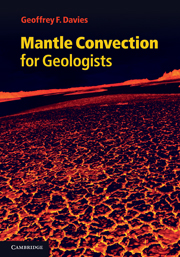Book contents
- Frontmatter
- Contents
- 1 Introduction
- 2 Context
- 3 Why moving plates?
- 4 Solid, yielding mantle
- 5 Convection
- 6 The plate mode of convection
- 7 The plume mode of convection
- 8 Perspective
- 9 Evolution and tectonics
- 10 Mantle chemical evolution
- 11 Assimilating mantle convection into geology
- Appendix A Exponential growth and decay
- Appendix B Thermal evolution details
- Appendix C Chemical evolution details
- References
- Index
2 - Context
Published online by Cambridge University Press: 03 May 2011
- Frontmatter
- Contents
- 1 Introduction
- 2 Context
- 3 Why moving plates?
- 4 Solid, yielding mantle
- 5 Convection
- 6 The plate mode of convection
- 7 The plume mode of convection
- 8 Perspective
- 9 Evolution and tectonics
- 10 Mantle chemical evolution
- 11 Assimilating mantle convection into geology
- Appendix A Exponential growth and decay
- Appendix B Thermal evolution details
- Appendix C Chemical evolution details
- References
- Index
Summary
Basic concepts and primary observations. Defining the crust, mantle and core. Distinguishing crust from lithosphere, continents from ocean basins. The distribution of topography and heat flux over the sea floor.
Mantle convection occurs, remarkably enough, in the Earth's mantle. It is affected by the crust, and part of the lithosphere plays a major role. There are peculiarities near the boundary of the mantle with the core that may significantly affect mantle convection, and that certainly tell us some important things about mantle convection. To discuss our subject sensibly, we had better be clear what all these terms refer to: mantle, crust, core, lithosphere and so on. That is one thing this chapter is about. There are also important constraints on mantle convection to be had from the form of the Earth's topography, and from the geographic variation of heat flow from the Earth's interior. These will also be summarised.
Crust, mantle, core
The major division of the Earth's interior is into crust, mantle and core. The boundaries between these regions were detected seismologically, in other words using the internal elastic waves generated by earthquakes, which are detected as they emerge at the Earth's surface. The variation of seismic velocities, and density, with depth in the Earth is shown in Figure 2.1. The boundary between the mantle and the core is at a depth of about 2900 km, where the seismic velocities drop, the shear velocity is zero and the density jumps.
- Type
- Chapter
- Information
- Mantle Convection for Geologists , pp. 4 - 12Publisher: Cambridge University PressPrint publication year: 2011



